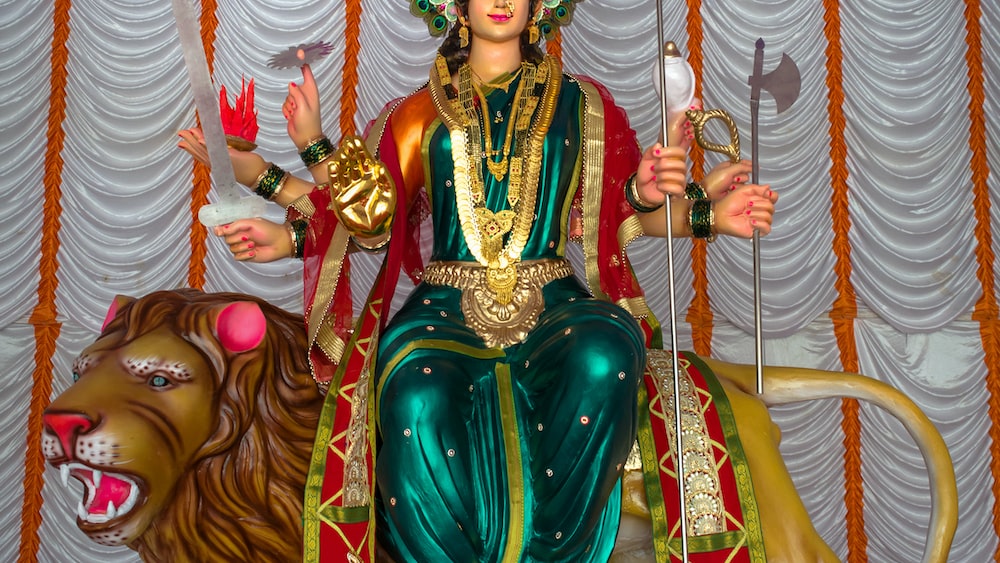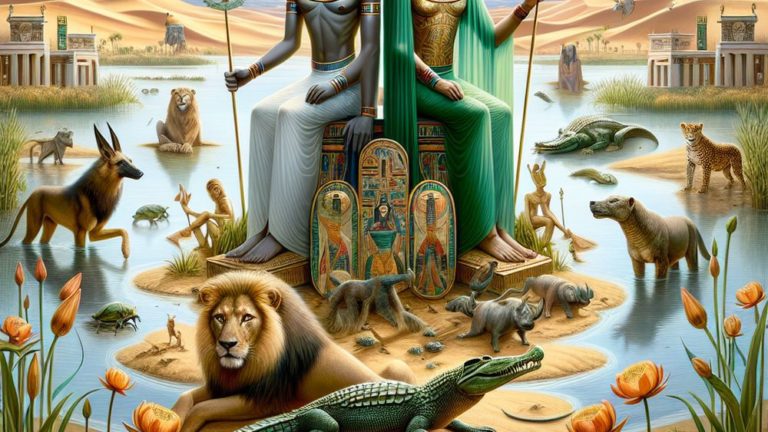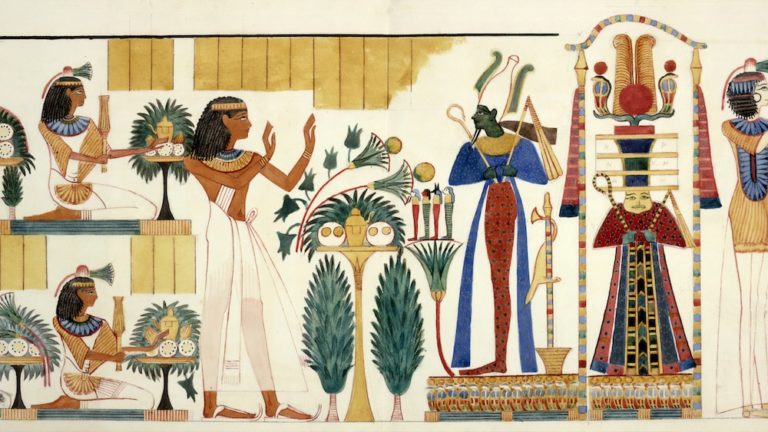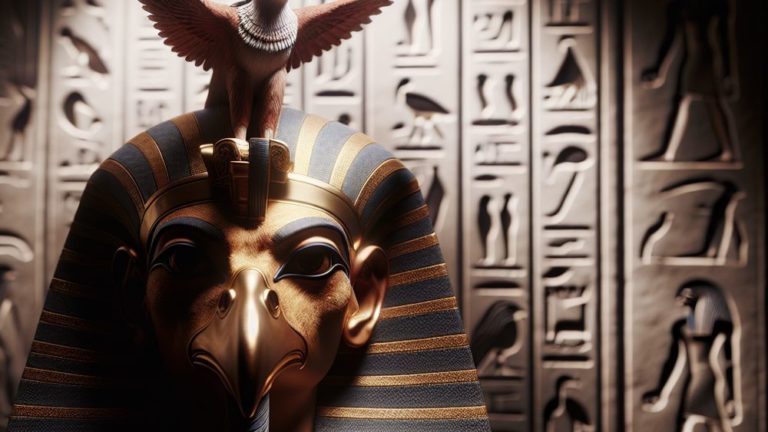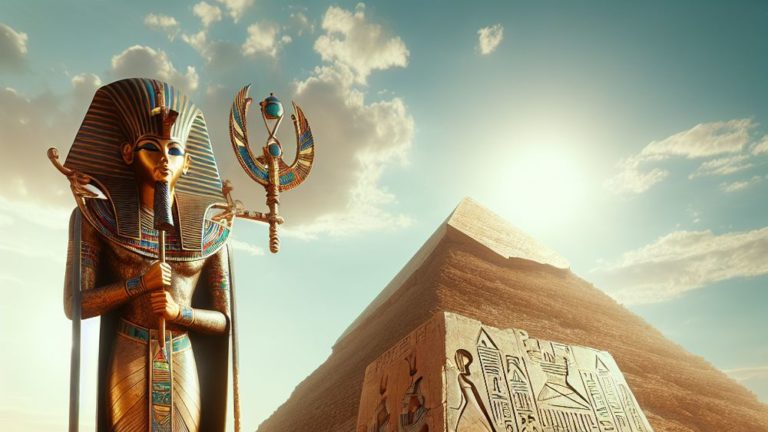Atum Egyptian God Symbol: The Primordial Deity Of Creation
Atum Egyptian God Symbol: The Primordial Deity Of Creation
The past is often shrouded in mystery and cloaked in shadows, but each historical discovery is a ray of light that unveils a fragment of the grand tapestry of human history. One such intriguing piece comes from the land of the Nile, a civilization steeped in history and mystery: Ancient Egypt. It is here that we dive into the ancient lore of one of the most revered deities of this enigmatic civilization – Atum, the Egyptian God. The symbolism associated with Atum, the Great God and Creator, forms a significant part of the Egyptian cosmological framework.
Venture with us into the heart of a civilization famed for its grand pyramids and hieroglyphics as we unmask the mysteries of Atum and his revered symbolism in the atum egyptian god symbol. Join us in traversing the corridors of time and let’s unravel the secrets of Atum together!
Understanding Atum: The Egyptian God
To truly comprehend and appreciate the mysteries of Atum, it is imperative to delve deeper into the portrayals and narratives around this deity. This journey takes us into the eons of mythology, symbolism, and cultural influence that embody the God of Creation.
Who is Atum?
Atum, often hailed as the ‘Complete One’, is a pivotal figure in ancient Egyptian mythology. He embodies the essence of a creation deity, the one who brought forth life from the chaotic waters of Nun. But who exactly is Atum? He is the Great God, the one who stands at the zenith of the cosmic hierarchy. As the sun sets, it takes the guise of Atum, signifying his association with the end of the day, just as he denotes the end of the cosmic cycle.
The mysteries that surround Atum are many, and his portrayal varies – sometimes seen as a primitive celestial deity, while at other times, appearing in the form of a majestic lion, a serpent, or even a bull. The depictions vary but the reverence for Atum is a constant. His cultural and religious influence played a vital role in the civilization of the Nile.
Atum, the ‘Complete One’ in ancient Egyptian mythology, is a pivotal figure who embodies the essence of creation and holds a significant role in the cosmic hierarchy.
Atum’s Role in Egyptian Mythology
In the complex labyrinth of ancient Egyptian Mythology, Atum stands as a testament to change, creation, and completion. The sacred texts christen him as he who “created the gods”. Not only was Atum a revered god but he was also the architect of gods and men. Every evening, the setting sun transformed into Atum, disappearing into the underworld only to reappear the following morning, rejuvenated and reborn.
This cyclical narrative of birth, death, and resurrection rendered Atum as the symbol of renewal. Moreover, he was the embodiment of the earthly realm and cosmic order, his existence a beacon symbolizing stability in the ever-volatile world. A understanding of Atum’s role places him at the heart of Egyptian mythology, beating in unison with the rhythm of life, death, and continuity.
The Symbolism of Atum
Deciphering the symbolism of Atum is akin to unraveling an ancient cipher. Each symbol associated with him carries a weighty meaning within the intricate tapestry of Egyptian beliefs, mirroring the multifaceted nature of this venerable deity.
The Iconography of Atum
The ancient Egyptians depicted Atum in numerous ways, each representation full of profound symbolism. Typically, he was portrayed as a man wearing a dual crown known as the Pschent, representing his dominion over Upper and Lower Egypt. The hieroglyphics traced his name, often decorated with a pair of erect cobras.
Atum was also depicted as a reclining lion, signifying his role as the finisher of the world. These diverse visual narrations weave into a larger image, one that reflects the vast expanse of his influence and the depth of his mystical godhood.
The Meaning Behind Atum’s Symbols
Unveiling the meaning behind Atum’s symbols transports us into a dimension where everything carries a symbolic meaning. The Pschent that Atum dons signifies his dominion over the Two Lands – Upper and Lower Egypt. The cobras represent his authority and divinity. His transformation into a lion is indicative of his role as the preserver and protector of creation.
Each symbol associated with Atum echoes with resilience, leadership, and ultimate control. These symbols carry tales of the past within their silent frames, narrating stories of divine power, cosmic balance, and Atum’s unparalleled dominion.
Atum and the Creation Myth
Coming to the pivotal role of Atum in the Egyptian creation myth involves an odyssey into the heart of antiquity. It is a tale as ancient as time itself, narrating the birth of the cosmos and the foundation underpinning life in Ancient Egypt.
The Story of Atum’s Self-Creation
The epic tale of Atum’s self-creation beckons from the echoing profundity of ancient Egyptian mythology. As the scrolls of ancient egyptian literature teach us, Atum emerged from the primal waters of chaos, Nu, much like a lotus blossom surfaces from the murky depths, its radiant petals basking in the sun’s glory. The solitary deity, embodying both male and female aspects, manifested himself through his own sheer will and divine power.
This creation event, in the eyes of early Egyptians, marked the dawn of existence. Utterly alone in the devoid cosmos, Atum did something extraordinary: he began the creation of the universe not by spoken command or by shaping elements, but through a much more visceral and intimate means. He engendered two offspring, Shu and Tefnut, through an act of divine autoparity, setting the course of Egyptian cosmology.
Atum’s Role in the Creation of Other Gods
The children of Atum, Shu and Tefnut, symbolizing air and moisture respectively, emerged from the deity’s divine essence. Following their creation, a canvas was now set for life’s unfoldment. Shu, acting out his role as the air, separated the sky from the earth, giving birth to the world as the ancient Egyptians knew it.
The saga continues, in layers of symbolic and mythic connotations. Shu and Tefnut went on to parent Geb and Nut, the gods of the earth and the sky. But it was Atum, through his original act of creative force, who had set this divine manifestation into motion, marking him as the generator of life, the divine architect of the universe.
Eons later, when humans sought wisdom, they drew upon well-preserved studies of this grand narrative. They marveled at the tale of their universe’s inception and found in its story an echo of human genesis, an echo manifested in the belief that the human ka, or spirit, was borne of Atum’s sneeze, signifying life’s divine inception.
Atum’s creative force set the divine manifestation into motion, making him the generator of life and the divine architect of the universe.
Atum’s Influence in Ancient Egypt
In the grand theater of ancient Egyptian civilization, Atum held a prominent role, symbolizing the everlasting cycle of death and rebirth. His narrative, etched deeply in the psyche, influenced societal norms, religious rites, and philosophical doctrines, shaping an entire epoch with its profound symbolic resonance.
Atum’s Significance in Ancient Egyptian Religion
Atum’s influence in Egyptian religion was monumental. As the cosmic creator, he was revered and worshiped, his attributes scribed onto towering obelisks and etched into sacred papyri. Tales of his self-creation and divine genealogy shaped the foundational tenets of Egyptian cosmogony.
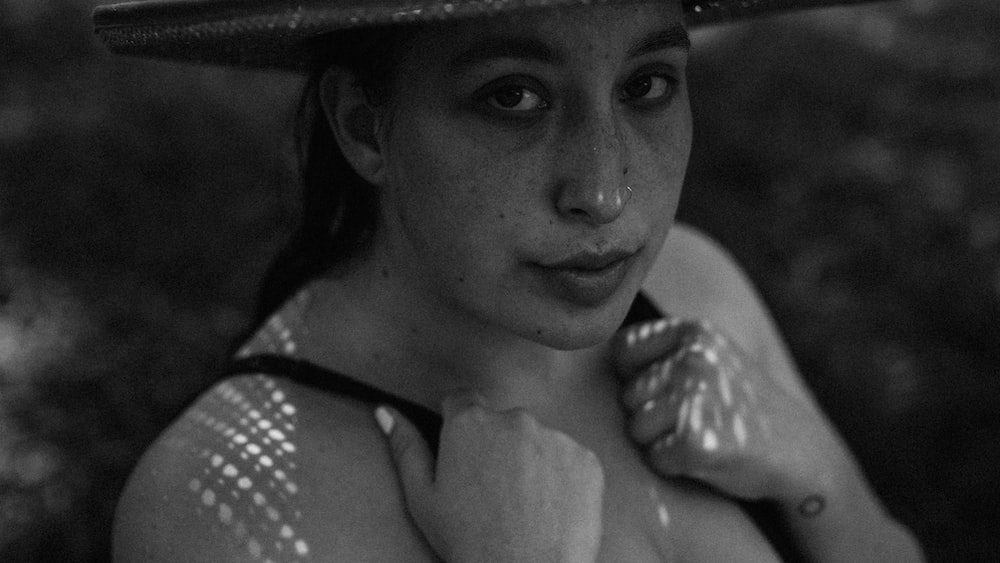
Communities offered solemn prayers and passionate hymns to Atum, seeking his divine protection. To the Egyptians, he was the carmine glow of sunset, the transition into the night, and the harbinger of sunrise, symbolizing the eternal cycle of existence and the promise of resurrection.
Furthermore, his dualistic nature – a materialization of the male and female principles – played a significant role in the maturation of Egyptian religious thoughts. It reinforced their belief in the harmonious duality governing the cosmos, a theme recurring in many Egyptian religious practices.
Atum’s Impact on Ancient Egyptian Culture
Not only was Atum influential in religious spheres, but his presence was also deeply interwoven into the fabric of Egyptian culture. The theme of creation and duality influenced Egyptian art and architecture, with many temples and structures dedicated to the deity manifesting these ideas.
The tale of Atum’s self-creation, and the subsequent genesis of the pantheon of gods, inspired countless depictions in Egyptian literature and art, becoming an essential part of their cultural heritage. Even ancient Egyptian end-of-life practices showed signs of Atum’s influence, as they would seek his guidance on their journey to the afterlife.
In astrology, too, Atum played a vital role. The Heliopolis cosmology, in particular, assigned a high degree of symbolic significance to Atum, positioning him as the deity presiding over the sun’s zenith and descent, further reinforcing his cultural significance.
Atum in Modern Interpretations
Today, the profound narrative of Atum’s self-creation and his vital role in ancient Egyptian religion continues to resonate, reflected in popular culture, academic discourses, and neopagan beliefs alike.
Atum’s Representation in Modern Media
The enduring narrative of Atum’s self-creation, and his subsequent cosmic acts of procreation, have spilled over from the ancient sands of Egypt into the mediums of modern storytelling. Books, film, and television often draw on the rich symbolism of the Atum Egyptian god symbol, exploring its profound meaning through the lens of contemporary interpretations.
In comic books and graphic novels, Atum is often portrayed as a celestial being of immense power, the very personification of creative force. The Marvel Comics universe, for instance, introduces him as Demogorge, the God-eater, embodying the concept of the devouring sun.
Moreover, documentaries and historical films depict the rich tableau of ancient Egypt, frequently featuring the deity’s myth in their explorations. Atum’s myth adds a fascinating layer to these narratives, serving as a symbolic testament to humanity’s eternal quest for understanding the mysteries of existence.
The Modern Significance of Atum’s Symbolism
Just as the ripples of a stone thrown into a lake stretch out far beyond its initial impact, so too do the antiquated yet powerful symbols of Atum echo in our present world. The representation of Atum has been captured not merely in texts and on walls, but also in the minds and hearts of those passionate about the enigmatic allure of ancient cultures. Today, the atum egyptian god symbol can be found adorning designs in modern fashion, architecture, as well as in philosophical and spiritual discussions. Its ubiquity serves as a reminder of our eternal quest to comprehend our beginnings, the universe, and our place within it.
The god Atum, for us today, is an embodiment of the spirit of creation and completion. The primordial power and mystique of the Atum symbolism resonate with many who strive for completeness and balance. Despite the passage of millennia, the symbols that once dominated the ancient sands of Egypt continue to find relevance, influencing contemporary thought and aesthetic sensibilities.
FAQs
1. What does Atum’s symbol represent?
The symbol of Atum represents the very essence of creation and completion. As the deity of pre-existence and post-existence in ancient Egyptian mythology, Atum embodies the cycle of birth, life, and death.
2. How did Atum contribute to the creation of the universe according to Egyptian mythology?
Atum’s contribution to the creation of the universe is profound according to Egyptian mythology. It is believed that Atum emerged from the chaotic waters of Nun, bringing existence into being from the sheer force of his will.
3. How was Atum worshipped in Ancient Egypt?
In Ancient Egypt, Atum was worshipped as both the first and the last god. Ceremonies honoring Atum were marked by their solemnity and reverence for this deity’s pivotal role in the cosmos’ creation and sustenance.
4. How is Atum represented in modern interpretations of Egyptian mythology?
In modern interpretations, Atum is often represented through his traditional iconography – a human figure wearing the Double Crown of Upper and Lower Egypt. But his most noticeable presentation is through abstract symbols indicating his role as a creation deity.
Conclusion
As we wrap our expedition into the intriguing world of Egyptian mythology, focusing specifically on the atum egyptian god symbol, we discover a powerful truth: symbols may change, transform, and evolve, but the core ideas they represent often remain deeply relevant.
The god Atum, alongside Shu and Tefnut, transcended time to remind us of our inherent potential for creation and completion, our silent strength to emerge from the chaos and craft our destinies. The importance of Atum in ancient and modern contexts invokes profound contemplation. Just by studying Atum, we become explorers and discoverers, finding and defining our place in this cosmic dance, just as Atum did at the beginning of time.
As your intrepid guide and overly-enthusiastic author, I assure you that our journey through history is far from over. With each passing moment, we write our story. And in the story of the universe, every moment is a symbol waiting to be decoded. So join me as we unravel the mysteries of the past and explore the potential of our future. Until then, keep seeking, keep discovering, and above all else, never lose your sense of wonder.
Happy exploring, Cedric

